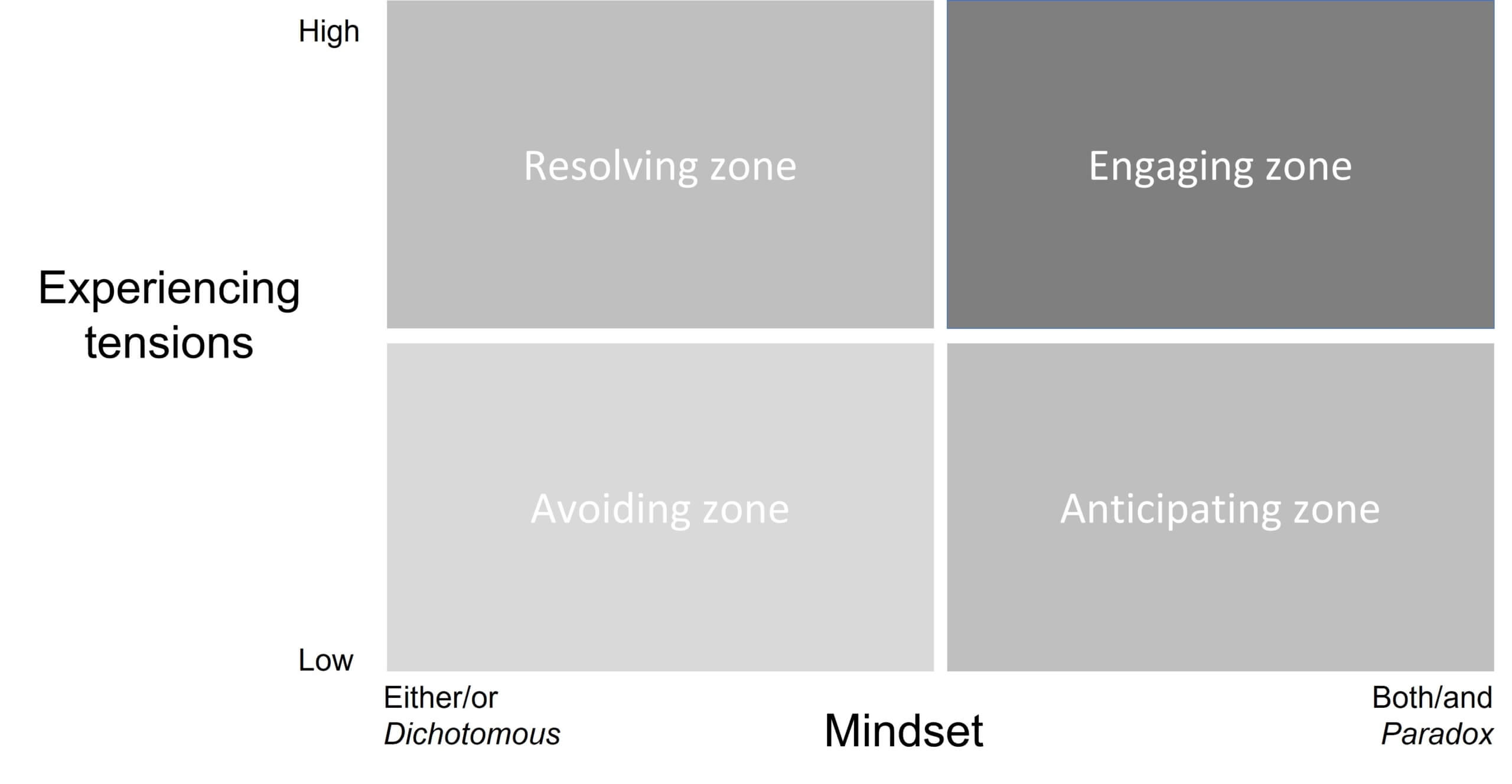Janet Perna felt immense pressure. In 1996, as the general manager of the Data Management Division of IBM, she was tasked with completely revamping her business unit without losing billions of dollars’ worth of existing revenue. Perna’s team needed to be ambidextrous. The task was daunting. She could easily fail. She knew how the threat of failure felt: only several years earlier, she, and the rest of IBM, had faced the near death of the organization. IBM laid off more than a hundred thousand people within three years. Perna was one of the lucky ones to remain. Or was she so lucky? The heat was on to prove to senior management that the company had kept the right person.
I was lucky enough to study IBM’s leaders like Perna in the late 1990’s and early 2000’s. Joining with members of Change Logic, I explored what it took for senior leaders of IBM’s strategic business units to be ambidextrous. Some were tremendously successful. Others failed miserably – either becoming stuck in the inertia of the existing world that they could not innovate, or becoming so infatuated with innovation that they left millions of dollars from the existing world on the table.
Perna was able to do both. She did so by creating an ambidextrous unit. She clarified an overarching identity, demanding that the unit remain #1 in the marketplace. She repeated this vision at every meeting. She created a subunit for innovation so that they could develop their own entrepreneurial culture, metrics and goals. She hired people with different skills to apply to the innovation1. She differentiated the skills needed to update the existing database from those needing to develop the innovative ones.
Perna also did something even more important. Underlying her decisions about vision, strategy and structure was her mindset about innovation. She adopted what we call a paradox mindset. She moved away from seeing innovations and existing products as an either/or. Instead, she valued the possibilities of a both/and.
Adopting a Paradox Mindset
Mindsets matter. As psychologist Paul Watzlawick once argued, the problem is not the problem; the problem is how we think about the problem. Research repeatedly demonstrates that how we think influences how we act. An ambidextrous approach starts with shifting our underlying thinking about innovation from a traditional, dichotomous mindset to a paradox mindset that allows us to cognitively hold two opposing forces at the same time and value their interdependence.
Shifting our assumptions is not easy. Engaging with paradox often brings us to the limits of our rational thought. We can feel queasy peering over the edge toward the absurd or the illogical. Such uncertainty and irrationality drive our anxiety. We pull back toward more clarity. But learning to value and accept tensions helps us avoid oversimplifying our presenting dilemmas and instead to explore more creative alternatives. That is, we need to move from more dichotomous mindsets that foster either/or thinking to paradox mindsets that empower both/and thinking.
In my own research with colleagues Marianne Lewis, Ella Miron-Spektor, Josh Keller, and Amy Ingram, we studied different approaches to competing demands and how these approaches affect creativity, performance, and job satisfaction. We surveyed more than three thousand people from the United States, China, and Israel. We found that people differ on two interwoven factors: the extent to which individuals experience tensions and the extent to which they adopt a paradox mindset.
First, people differ in how much they experience tensions. Such differences can stem from varying situations, as some environments are filled with more tensions than others. As our Israeli team member likes to point out—living with ongoing regional conflict in the Middle East creates tensions very different from those felt by, say, someone living on a sheep farm in rural New Zealand. Similarly, an emergency room physician might be surrounded by more tensions than a yoga instructor. The context can have a great impact on our experience of tensions.
As we noted previously, our own research suggests that people experience increased tensions in settings with (1) faster change, (2) greater plurality, or (3) more scarcity. The faster the pace of change, the more we experience tensions between what is and what will be. In terms of plurality, the more voices and perspectives from different people and stakeholders, the more we experience tensions between varied goals, roles, and values. And finally, the more that people experience a scarcity of resources, the more competition there will be over how the resources should be shared.2
Even as the nature of tensions in our environment varies, it is also the case that some people are more attuned to tensions than others. Tensions swirl all around us. Some people seek them out, purposefully surfacing tensions to enable more creativity. Others may avoid or ignore them to minimize potential conflicts. Yet even two people in the same situation can experience varying degrees of tension. In our own research, we found that people who all had the same job and worked in the same organization reported different levels of tensions.
Second, people vary in how they understand the relationship between opposing forces. People with a more dichotomous mindset narrow their thinking to frame alternatives as a binary choice and then choose between them. A paradox mindset instead involves appreciating contradictions between opposing forces and recognizing how they are mutually reinforcing. Those with a high paradox mindset tend to accept tensions as natural, valuable, and energizing. Rather than asking if they should choose option A or option B when confronting dilemmas, they ask, “How can I accommodate A and B at the same time?” Just changing the question introduces new options and invites both/and thinking.
Zones of Paradox Mindsets
In combination, the extent to which we experience tensions and the mindsets we adopt determine the different zones of navigating paradoxes. In the avoiding zone, we experience limited tensions and adopt a dichotomous mindset of either/or thinking. We may blissfully be in a stress-free environment. Or we may live or work in a stressful environment but blissfully ignore the tensions swirling around us. Of course, blissful ignorance is sometimes valuable. We don’t have the time and energy to address every tension that arises. For example, we might be actively ignoring a recurring question about our professional achievement and social impact at work because other life factors need us to postpone a major career change. Sometimes, we need to pick our battles.

While we can avoid tensions sometimes, we can’t always ignore them. At some point, those subtle work tensions may burst forward, posing a pressing challenge. Or one day, we will find ourselves in a new situation with more overt and trying pressures. For example, work might be relatively stress-free until we get a new boss and stuff really starts hitting the fan. What happens when those tensions rear their heads? Do we have the tools to navigate them? When we adopt a dichotomous mindset, the uncertainty of the decision may leave us feeling uncomfortable, and we want to quickly make an either/or choice. We are in the resolving zone. The either/or decisions that we make in the resolving zone might lead us to a sense of relief in the short term, but watch out. As we detailed in chapter 2, in the long term, those decisions are limited at best and detrimental at worst, sparking vicious cycles.
On the flip side, we may tend to adopt a paradox mindset, ready to simultaneously engage interdependent contradictions. “Paradox?” you might think. “Bring it on!” In the anticipating zone, we draw on a paradox mindset but experience few tensions. We are all dressed up with nowhere to go. Again, we might be in a low-stress situation. Yet once the context changes, we will be poised for both/and thinking. However, we can also start uncovering the tensions that exist around us. Rather than sweep them under the cognitive rug, we can bring them out in the open to deal with them. Many of the leaders profiled in this book do just that. Outfitted with the tools of both/and thinking, they seek out underlying paradoxes to address them head-on and to generate solutions that are more creative and sustainable. Doing so moves us into the engaging zone—where we both experience tensions and adopt a paradox mindset.
In our research, we explored how these zones impact people at work. We found that the people in the engaging zone performed better at work. They were seen as more innovative and productive by their managers. Not only that, but they were also more satisfied with their jobs.3 As it turns out, if we are going to adopt a dichotomous mindset, we perform better in situations that involve a lower degree of tensions. That is, if we are immersed in either/or thinking, it’s better to have fewer tensions or avoid the ones that come our way, given that our approaches to addressing them are limited. Once we experience more tensions, a paradox mindset offers us the tools to more effectively respond. From our research, we developed the paradox mindset inventory to assess the extent to which people experience tensions and adopt a paradox mindset. You too can test your mindset, share it with your friends, or use it in your organization.4
This article is reprinted by permission of Harvard Business Review Press. Excerpted from BOTH/AND THINKING: Embracing Creative Tensions to Solve Your Toughest Problems by Wendy K. Smith and Marianne W. Lewis. Copyright 2022 Harvard Business School Publishing Corporation. All rights reserved.
[av_hr class=’full’ icon_select=’yes’ icon=’ue808′ font=’entypo-fontello’ position=’center’ shadow=’no-shadow’ height=’50’ custom_border=’av-border-thin’ custom_width=’50px’ custom_margin_top=’30px’ custom_margin_bottom=’30px’ custom_border_color=” custom_icon_color=” id=” custom_class=” template_class=” av_uid=’av-qcbp6b’ sc_version=’1.0′ admin_preview_bg=”]
1 For more on this work, see Tushman, M. L., Smith, W. K., & Binns, A. 2011. The Ambidextrous CEO. Harvard Business Review, 89(6): 1700-1706; Binns, A., O’Reilly, C. A., & Tushman, M. 2022. Corporate explorer: How corporations beat startups at the innovation game: John Wiley & Sons.
2 See Smith, W. K., & Lewis, M. W. 2011. Toward a theory of paradox: A dynamic equilibrium model of organizing. Academy of Management Review, 36(2): 381-403.
3 For more information about the paradox mindset and the paradox mindset inventory, see Miron-Spektor, E., Ingram, A. S., Keller, J., Smith, W. K., & Lewis, M. W. 2018. Microfoundations of organizational paradox: The problem is how we think about the problem. Academy of Management Journal, 61(1): 26-45.
4 You can access the Paradox Mindset Inventory at paradox.lerner.udel.edu.
